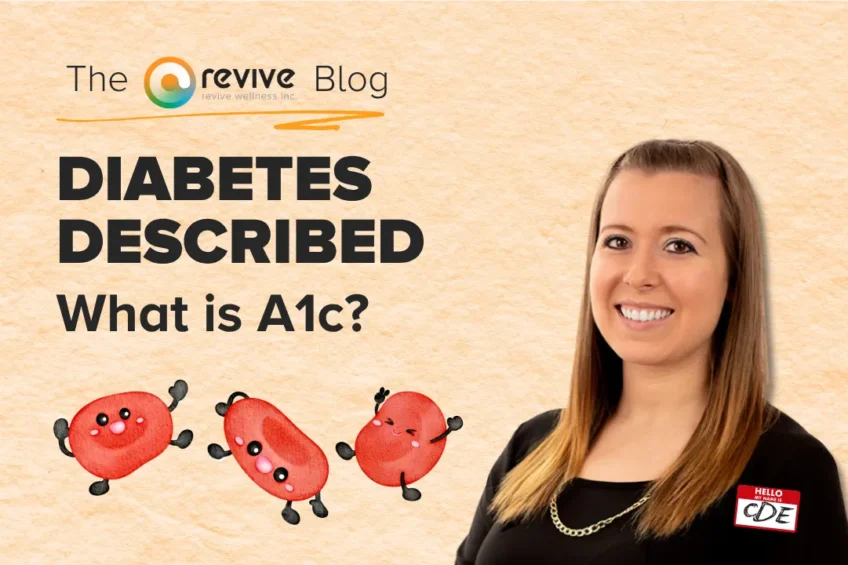Diabetes Described: What is A1c?
- Kaylee Turner
- June 6, 2025
If you’re living with diabetes—or simply want to understand your risk—it can be overwhelming to know where to start. One of the most important tools in diabetes care is also one of the simplest: the A1c test. This routine blood test gives a clear picture of your average blood glucose levels over the past three months, offering valuable insights into how your body is managing sugar day-to-day. At Revive Wellness, we believe that knowledge is empowering—especially when it helps you take charge of your health with confidence and support.
What is an A1c Test?
The A1c test—also known as a hemoglobin A1c or glycohemoglobin test—is a simple blood test that gives insight into your average blood glucose (sugar) levels over the past three months. It measures how much glucose is attached to hemoglobin in your red blood cells. Since these cells have a lifespan of about 90 days, the A1c test provides a long-term picture of blood glucose trends. The results are shown as a percentage—the higher the number, the more glucose is present in your blood (1-5).
Why Does A1c Matter?
The A1c test is an essential tool for diagnosing prediabetes and diabetes.
If you’re already living with diabetes, regular A1c tests help you and your healthcare team understand how well your blood glucose has been managed over time (1). This information allows for adjustments to your care plan, empowering you to make informed choices about your health. Even if your A1c is higher than your target, it’s an opportunity to reflect, ask questions, and fine-tune your management approach.
How Often Should You Check Your A1c?
- If you don’t have diabetes: Diabetes Canada recommends screening for type 2 diabetes every three years for people over the age of 40 (2).
- If you are living with diabetes: Your healthcare team will recommend more frequent A1c tests, typically every three months if your blood glucose levels aren’t within target range or if your diabetes management plan is being adjusted (2).
Understanding A1c Targets
A1c percentage helps determine whether blood glucose levels are within a healthy range:
- Normal: 4.3% – 5.9% (1)
- Prediabetes: 6.0% – 6.4% (1)
- Diabetes: Diagnosed when A1c is 6.5% or higher on two separate tests (1, 2)
For most people living with diabetes, the target A1c is below 7.0%, but this can vary between 6.5% and 8.5%depending on individual health goals (3).
How Does A1c Compare to Daily Blood Glucose Readings?
A1c results reflect average blood glucose levels. For people who are self monitoring blood glucose levels at home the A1c can help you interpret the readings. Here’s how they compare:
| A1c | Average Blood Glucose Level |
|---|---|
| 6.0% | 7.0 mmol/L |
| 7.0% | 8.6 mmol/L |
| 8.0% | 10.2 mmol/L |
| 9.0% | 11.8 mmol/L |
| 10.0% | 13.4 mmol/L |
| 11.0% | 14.9 mmol/L |
| 12.0% | 16.5 mmol/L |
Your A1c result reflects your overall blood glucose trends, while home blood glucose readings show real-time levels. If your A1c is 8%, your average blood glucose throughout the day is likely around 10.2 mmol/L—but individual readings may fluctuate based on meals, activity, and other factors (3).
How Can You Lower Your A1c?
Even a 1% reduction in A1c can lower the risk of eye disease, kidney disease, and nerve damage by up to 25%—that’s a significant impact on your long-term health (3)!
Lowering your A1c isn’t about drastic changes—it’s about small, sustainable habits that add up over time. And the best part? You don’t have to do it alone! Your healthcare team is here to support you (4, 5).
Strategies to lower A1c include:
✅ Eating regularly throughout the day
✅ Balancing meals and snacks
✅ Staying active in ways you enjoy
✅ Managing stress and getting quality sleep
✅ Taking medications as prescribed
✅ Monitoring blood sugar at home
Ready to Take Charge of Your A1c?
If you’re looking for personalized support, book a discovery session with Kaylee, our Registered Dietitian and Certified Diabetes Educator. She’ll answer all your questions and help you take control of your diabetes management. Click the link here to book a discovery call today!
Continue reading:
👉 Diabetes Described Series: I was just diagnosed with diabetes. What should I do next?
About the Author

Kaylee Turner
When I was younger, I knew I wanted a career where I could help people and make a difference in their lives. We live in a world where diabetes and chronic diseases are so common, and the problem is that many people don’t know where to find reliable information. I take pride in keeping up to date on research, attending conferences around diabetes, and providing the best evidence-based care possible. I have specialized in diabetes full-time since 2020, and I completed my Certified Diabetes Educator (CDE) certification in 2023.
References
Punthakee, Z., Goldenberg, R., & Katz, P. (2018). Definition, Classification and Diagnosis of Diabetes, Prediabetes and Metabolic Syndrome. Canadian Journal of Diabetes, 42, S10–S15. https://doi.org/10.1016/j.jcjd.2017.10.003
Ekoe, J.-M., Goldenberg, R., & Katz, P. (2018). Screening for Diabetes in Adults. Canadian Journal of Diabetes, 42, S16–S19. https://doi.org/10.1016/j.jcjd.2017.10.004
- Also found at https://guidelines.diabetes.ca/cpg/chapter4
Imran, S. A., Agarwal, G., Bajaj, H. S., & Ross, S. (2018). Targets for Glycemic Control. Canadian Journal of Diabetes, 42, S42–S46. https://doi.org/10.1016/j.jcjd.2017.10.030
- Also found at https://guidelines.diabetes.ca/cpg/chapter8
Berard, L. D., Siemens, R., & Woo, V. (2018). Monitoring Glycemic Control. Canadian Journal of Diabetes, 42, S47–S53. https://doi.org/10.1016/j.jcjd.2017.10.007
- Also found at https://guidelines.diabetes.ca/cpg/chapter9
Hemoglobin a1c (Hba1c)—Diabetes educators calgary. (n.d.). Retrieved May 29, 2024, from https://diabeteseducatorscalgary.ca/other/diabetes-overview/a1c.html

